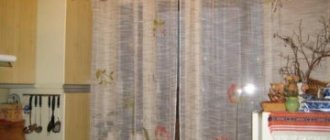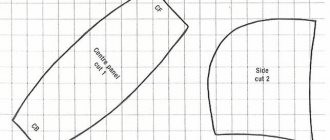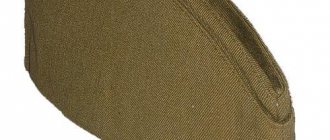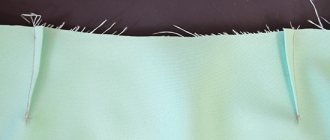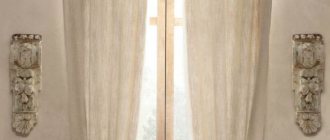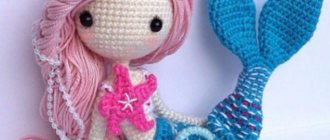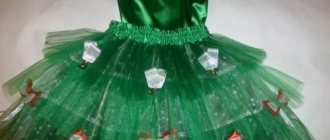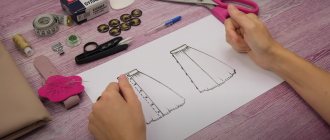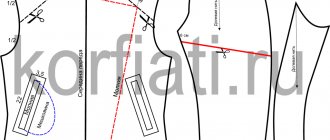A bed with a good, comfortable mattress is the key to a restful, healthy sleep. To keep it clean longer, it is better to use a protective fabric covering that you can make yourself.
The mattress pad should be thick enough to better protect the mattress and securely attach to it.
Not everyone believes that its presence is necessary, but the beneficial properties speak for themselves:
- reliably protects against contamination;
- preserves the original appearance of the mattress for a long time;
- protects against the appearance of allergens and dust on the surface.
A mattress cover or pad primarily performs a hygienic function - it protects the mattress from dirt, it is easy to remove and wash.
How to sew a mattress cover with your own hands
Sewing is not an activity that everyone can do, but almost every housewife can make a mattress cover. You will need to buy the fabric you like, and then:
- acquire dressmaker's tools: scissors, threads, needles, measuring tape;
- prepare the iron;
- set up the sewing machine.
The simplest one looks like a large pillowcase or bag.
To prevent it from “slipping,” you can simulate a button closure or zipper. There are other options for fastening.
Selecting tools
Before you start sewing a mattress cover, you need to prepare the tools that you may need:
- to create a pattern - paper, ruler, pencil.
- scissors;
- tape measure;
- chalk or pins for transferring the pattern onto the fabric;
- threads and needles;
- sewing machine;
- fabric and elastic.
You will need a standard set of sewing tools
How to sew a mattress cover with an elastic band - simple instructions
A mattress cover with an elastic band assumes the presence of sides
In order for the product to hold firmly, reliable fastening is required in various ways. You can always learn how to sew from expert consultations. For sewing you need:
- prepare sewing tools;
- choose the material you like based on your ideas about the appropriateness of use and beauty;
If the mattress cover should protect only from dirt and dust, choose thick cotton, linen, jacquard, thin terry cloth, bamboo
If you also need waterproof functions, we take fabric or material with waterproof lamination
A quilted mattress cover with a thin padding polyester layer is good for winter, it retains heat
Jacquard or silk mattress cover, good in hot weather, as it gives a feeling of coolness - buy an elastic band – wide or underwear;
- make a pattern by measuring the length and width, and if necessary, the height.
Pattern with allowances for sewing a mattress cover with an elastic band
The order of sewing operations, if the skill is small, can be found on the Internet.
Making a zippered cover
A mattress cover with a zipper should be sewn by those who have experience working with similar accessories. The feather bed will be protected from all sides. The zipper is sewn in both on the long end side and on the short side. The first option is preferable, since removing the cover is much more convenient.
Necessary manipulations:
- Measurements are taken of the main product.
- Rectangles are cut out on stretched and ironed fabric. The side parts are done after. To cut out the sides, you should use one piece of fabric, which will help avoid additional seams.
- The seam allowance will be 1 cm.
- Patterns are made independently. Basting is done from the wrong side to each other. Afterwards it is built up.
- The zipper is sewn in when connecting the bottom of the mattress cover to its side or end side. All seams should be overlocked.
We sew a mattress cover with an elastic band with our own hands
Transfer the pattern to the fabric and cut out the mattress cover piece
Correctly folding the edges of the cutouts
A protective covering sewn with your own hands can be the first experience and pride of even an inexperienced craftswoman. To work, you will need a machine, traditional tailor's tools, fabric, accessories, a little skill and effort.
We sew and process the edges of our cutouts on all sides
We bend and iron all the free edges of the mattress cover
We sew the hem around the entire perimeter, leaving an opening about 4-5 cm wide
When choosing a material, you should pay attention to strength: it should not quickly wear out or tear.
Using a safety pin, thread the elastic into the drawstring
We cut the elastic a few centimeters longer than necessary, fold its ends, sew several times, closing the elastic in a circle
Having made measurements: length, width and height, you can start creating a pattern, and then sewing. Fastenings are sewn in along the edges, reliability is checked by fitting.
We sew up the remaining hole - the mattress cover is ready
Fabric selection
The fabric should not only look stylish, but also be easy to wash. Quite often, even in fabric catalogs, only dry cleaning or dry cleaning is indicated as a method of cleaning textile material. However, as practice shows, this does not mean that washing is contraindicated.
To avoid sewing again, buy a small piece of fabric you like and wash it in a washing machine at a water temperature of 30°C (flocked fabric will not survive washing - it will peel off, don’t even try to use it).
Measure the cut before washing - further comparison will show whether shrinkage has occurred. Assess for discoloration, appearance or absence of lint. If the results of the experiments are positive, this piece of fabric will come in handy: you can use it to upholster a chair or make a cover for a sofa cushion.
- Since furniture fabric is not cheap, sew the invisible part of the cover from calico.
- Before cutting, the fabric should be washed, especially calico, which noticeably decreases in size. In addition, the calico must be ironed with steam.
- To determine the required amount of material, lay out the patterns on a checkered sheet. Don't forget to reserve material for shrinkage when cutting.
How to sew a mattress cover: step-by-step instructions
In order to make our future cover, we need to measure the length of the mattress a, width b, and side height h
The need to protect the product from contamination is quite justified: with its help, it stays clean longer and maintains an attractive appearance. The sequence of work can be learned from simple instructions, which will not be difficult to implement even for a novice home craftswoman:
- buy fabric;
- prepare tools for cutting and sewing: sewing machine, measuring tape, thread, needles, scissors, chalk, elastic band, iron;
- take exact measurements.
Attention! Before you start cutting, it is important to wash the purchased material: it can “shrink”.
We set aside ½ the width of the mattress from the fold line, on each side we set it aside to the left, to the right, and from the bottom h+15 cm
Cut out squares at the corners with scissors
Experienced home craftswomen advise carefully checking the dimensions of the product before cutting.
Advice. For inexperienced housewives, it is better to make a life-size template and check the correctness of certain dimensions.
We transfer the pattern to the fabric, sew down sections C and C1, process the edges of the cut, and make a hem stitch along the entire product
Once the check has been completed, you can begin cutting, having first ironed the fabric well. The main part is cut taking into account the length and width, then 4 side fragments are cut out if the mattress is high.
We retreat from the corner 50 cm, thread the elastic, secure the ends of the elastic with stitches - we get gathering in the corners
All parts are double stitched and folded inside out, then turned inside out.
If the fitting was successful, you can create a drawstring. Iron the finished product.
Ready-made mattress cover with elastic band with gathering in the corners
What materials and tools will be needed
Even those who last sat down at a sewing machine in high school can sew a mattress cover with their own hands.
Measurements
The first step is to decide how much fabric you will need. To do this, we measure the mattress: length, width, height. The piece of fabric must be at least:
- double length mattress;
- its double width;
- if the model has sides, then you need to add the height of the mattress, multiplied by 4, while two heights are cut in width, and two in length; if you are sewing a cover with corner elastic bands that will not protect the sides of the mattress, then the height is not taken into account .
Don't forget to allow seam allowances on all sides of the garment.
Fabric selection
First, let's decide on the material, as well as the functions that the product will perform.
If you want to extend the life of your mattress by protecting it from dust and dirt, then use fabrics that do not stain, do not shrink after washing, and do not fade. In this case, the coating will not spoil the sheets, and it can be easily washed without fear that after drying it will no longer fit. One of the successful options could be jacquard - a natural material that contains a small amount of synthetic fabrics. Silk is also suitable if you want a luxurious option, but keep in mind that silk is more difficult to work with due to its slippery surface. Simpler fabrics are chintz and calico, which are often used if you need to sew a mattress cover for a kindergarten.
To make the case waterproof, use special rubberized fabrics. If their surface is not too comfortable for the body, use the inner layer.
You will also need a border for processing seams, as well as fastenings of your choice:
- or thick wide elastic bands for fixing at the corners (2 pieces, if the model has opposite elastic bands, 4 pieces - for sewing into all corners);
- or an elastic band, the length of which is equal to the perimeter of the mattress minus approximately 40 cm.
Preparing tools
In addition to fabric you will need:
- spools of thread;
- scissors;
- chalk, which can be replaced with a simple pencil if the fabric is light, or with a piece of soap if it is dark;
If traces of soap, a simple pencil or chalk are visible on the finished product, do not worry. They will disappear after washing.
- centimeter (you can use a construction tape);
- safety and single-pin pins;
- sewing machine.
How to sew a mattress cover for a baby
You can make a cover for a children's mattress with a zipper yourself
It is very easy to make a cover for a children's mattress. How to sew it yourself is easy to understand from the recommendations. You will need:
- take measurements;
- purchase and wash fabric;
- prepare tailoring tools and machine;
- cut out two rectangles: one to size, the second with an allowance of 2-3 cm on each side.
Three sides and part of the fourth, where a zipper or buttons will be sewn, are stitched and stitched by hand.
When a zipper is used, it is first basted and tried on. If everything is done correctly, it is sewn into place. After ironing, the cover can be put on.
Benefits of a branded product
If the DIY process turns out to be too complicated or there is simply no time for it, you can turn to traditional methods and purchase a branded product. The Molto Bene company offers options for Italian mattresses for every taste. A wide range of inexpensive and affordable models, original and exclusive options.
And in conclusion, I would like to note that the main advantages of high-quality mattresses are sound and healthy sleep, the adoption of an anatomical position for the spine and joints. The design of the mattress is designed in such a way as to relieve tension from the entire body and allow muscles to relax.
PLEASE SHARE THIS POST!
DIY mattress cover for children and adults
For a mattress for a child and an adult, the covering is made according to the same pattern. This takes into account the material, quality and texture, in accordance with the purpose of use.
The main conditions for a good result are:
- strict adherence to dimensions;
- washing the fabric before cutting;
- careful handling of corners;
- the reliability of the fastener or the correct fastening.
When choosing a fabric, especially when it comes to a children's product, it is important to pay attention to its composition, which should not cause allergies.
Decorating a sofa cushion
Cushions have clearly defined edges. The cover is cut into three parts: front, back and side (it is called a sheathing strip). Cord or other type of edge trim is sewn into the seams to achieve a well-defined shape. When adding a top finish to a seat cushion, remember that durability should be an important quality of the finish.
- Turn the cover right side out.
- Insert the foam mold, then blind stitch the opening.
To give the finished pillow a more finished and luxurious look, wrap the foam block with a regular or low polyester backing. To design this type of sofa cushion cover with your own hands, sew the edges of the cut together. Then wrap the pillow form in cellophane (a clean old bag will do just fine). Insert the pillow shape into the cover, then carefully remove the cellophane.
Most sofa cushions have some type of edge trim. However, if you are making a ruffled (rubbed) pillow, you may decide not to add a special design.
Baste the trim in place along the seam line on the front and back sections of the pillow.
Look how beautiful the hand-made sofa cushions look in these photos:
Pattern for a mattress cover with corner elastic bands
We pin the elastic bands to the corners of the mattress cover from the inside out
The model is quite simple. Elastic bands are sewn along the edges of the cut out rectangles to secure them to the surface of the mattress. The pattern can be found on the Internet.
Having folded the rapeseed tape in half lengthwise, we pin it along the entire perimeter of the mattress cover, grab the ends of the elastic, and stitch
Sewing a mattress cover
The amount of fabric depends on the type of case chosen and whether a padding polyester layer is sewn on.
For sewing bedding, they sell special material that is the same width as the mattress. Therefore, there is no need to sew the main part from several pieces of fabric. The price of such material is determined only by the length of the product.
The sheet model can be single-layer or double-layer. A padding polyester is sewn into a two-layer case, so they buy 2 times more fabric. Insulation is taken according to product measurements.
Mattress cover with corner elastic bands
First, a rectangle is cut out for a single-layer cover according to preliminary measurements. For a two-layer model, you need two identical rectangles, but it is better to add 3-5 cm so that the insulation does not bunch up at the edges. The corners are cut out according to the template.
- On a smooth surface lay a layer of fabric, padding polyester and again fabric. To ensure that everything is the same, the corners and cuts are aligned.
- The edges are pinned, then the product needs to be swept around the perimeter.
- The mattress cover is quilted, lines are marked in stages, and pins are pierced along the line.
- After stitching, the product is tried on. Excess edges are cut off.
- The elastic bands are pinned on the inside and the case is tried on again.
- Cut out bias tape, the width of which is the width of the finished part multiplied by 4, and 2 cm for thickness. The parts of the binding are connected at an angle of 45°.
- Stitch the binding on one side in a taut state.
- The trim is sewn on the outside so that the cut turns inward.
- Iron along the edges.
Case with sides
A cover with sides is sewn in two ways:
- Rectangle with rounded corners and stitched edges. This option is suitable for large mattresses. The parts rounded to the shape of an angle look neat.
- A rectangle, to the dimensions of which the width of the sides, backing and allowance are immediately added. This is a simplified method, but the corners are sharp and do not look so neat and beautiful.
After choosing the sewing method, all that remains is to assemble the parts:
- Prepare the side strip. The bottom edge is made by folding the closed edge and leaving a hole for the elastic.
- Sew the strip to the main part of the product.
- Cover the cut.
- Retract the elastic band.
Case with zipper
One of the options for a mattress cover is a case with a clasp. This is convenient because the sheet does not slip. The zipper is sewn between the main part of the product and the side part. But the problem is to find such a long zipper that can be sewn into the product.
Instead of a regular zipper, buy a pair of one-piece fasteners with larger teeth. The length of such a fastener is at least 85 cm. They are sewn symmetrically either into the head of the cover or on one of the sides. The sewn product is completely unzipped and the mattress is inserted. It can be easily taken out of the case.
Cover-sheet
Zippered cases are convenient, but they are not so easy to make. The sheet cover does not require so much effort. For such a mattress cover you only need an elastic band. It is worn like a regular sheet. This option is best suited for tall mattresses.
For standard-sized mattresses, you can buy such a sheet in a store, but if the sizes are individual, you can sew a mattress cover yourself.
You will have to tinker with calico or calico fabrics. Their standard width of about 2 meters is not enough. Material is added to the sides to ensure the product fits properly.
Knitted sheets are practical. They don't need to be ironed because they always look neat. If you sew a case from this material, you need to process the edges so that they do not unravel.
Children's mattress cover
A good filler for a children's mattress is synthetic winterizer, foam rubber or batting. Quilted batting is also suitable; you can buy it at fabric stores.
Advice! The basic dimensions of the stroller are 80 cm in length and 40 cm in width. For a children's bed – 140 cm long and 70 cm wide.
Natural fabric for a children's mattress is pre-soaked in warm water and ironed. If this is not done, then during the first wash the mattress cover will shrink and it will not be possible to tighten it.
To sew a cover you need:
- a piece of foam rubber according to the size of the mattress;
- textile;
- zipper 20 cm long;
- sewing machine;
- scissors;
- ruler and measuring tape;
- pencil;
- paper.
To make a baby mattress pad:
- A drawing of two rectangles is drawn on paper. Measure 2 cm from the sides of the first rectangle. The second rectangle is drawn inside the other. The sides of the second rectangle are at a distance of 2-3 cm from the sides of the outer one.
- Sew in a zipper. To do this, two rectangles are folded and stitched, leaving a hole for the zipper.
- The two sides to which the zipper is sewn are ironed to make the fold convenient for sewing
- Sew the case along the narrow lines left on the drawing. After this, turn the product inside out and insert foam rubber.
- The corners of the case are decorated with thread pompoms.
Cushion cover
Pillows of the same size are a good material for making a mattress for children. A large fabric bag is divided into sections into which pillows are placed. This product is like a playground. It is convenient for children to play on it. The kids will not hit themselves, as they will fall on soft pillows. Velcro is sewn to the edges so that the pillows can be easily pulled out and the product can be folded.
Cover for orthopedic mattress
An orthopedic mattress is expensive, so a cover for it will also be expensive, and many housewives sew it themselves. In order for the result to please you, the fabric needs to be:
- antistatic;
- hypoallergenic;
- breathable;
- did not absorb moisture;
- did not accumulate dust.
Jacquard is considered the most suitable, dense, durable, with a variety of colors.
You can use natural linen, cotton, as well as synthetic and mixed fabrics that do not cause allergies.
Removable or non-removable cover
Modern equipment allows us to produce mattresses with removable covers. To do this, a cover is made, which is then put on the mattress. There is no tight fit between the fabrics and the filler. Removable models are characterized as practical and, if necessary, allow you to remove and wash the cover or take the product to the dry cleaner. It is problematic to put on and take off the mattress yourself. Some materials shrink greatly after washing, making subsequent use almost impossible.
Removable models do not fit tightly to the structure, unlike non-removable models. The surface of the material may be slippery and wrinkles may form in the corners. This will lead to a decrease in the service life of the mattress and loss of orthopedic properties. Edging equipment makes it possible to produce non-removable covers. In this case, the material will be sewn to the filler of the finished structure. The adherence of the material to the filler will be excellent, but it will be almost impossible to do anything if the surface is heavily contaminated.
Removing covers is not recommended by experts, who claim that the best way to remove dirt and put the product in order is to call dry cleaning at home. The cover cannot be cleaned on your own. Mattress covers will help prevent stains and signs of wear on the product. The cover is easy to remove and can be washed frequently. The main requirement is the breathability of the selected material, its strength, hydrophobicity and elasticity. In the manufacture of mattress covers, a special type of material is used that provides excellent air exchange.
Evaporating moisture will not allow insects and harmful microorganisms to grow inside the mattress structure. The absence of dust will prevent the formation of allergic reactions. Covers made of wool, linen and cotton are characterized by a high level of strength. Jacquard is considered the most durable and wear-resistant material. Cheap mattresses are dressed in polycotton. The most commonly used stretch is cotton-based. Orthopedic products are sheathed with natural fabrics that contain synthetic fibers that make them elastic. Hydrophobicity will protect the product from moisture, mold, and unpleasant odors.
Photo gallery of different types of mattress covers for children and adults:
PreviousMattressesWhich mattress is better, more practical: spring or springless?
Next
MattressesHow and with what to seal an intex air mattress at home?
